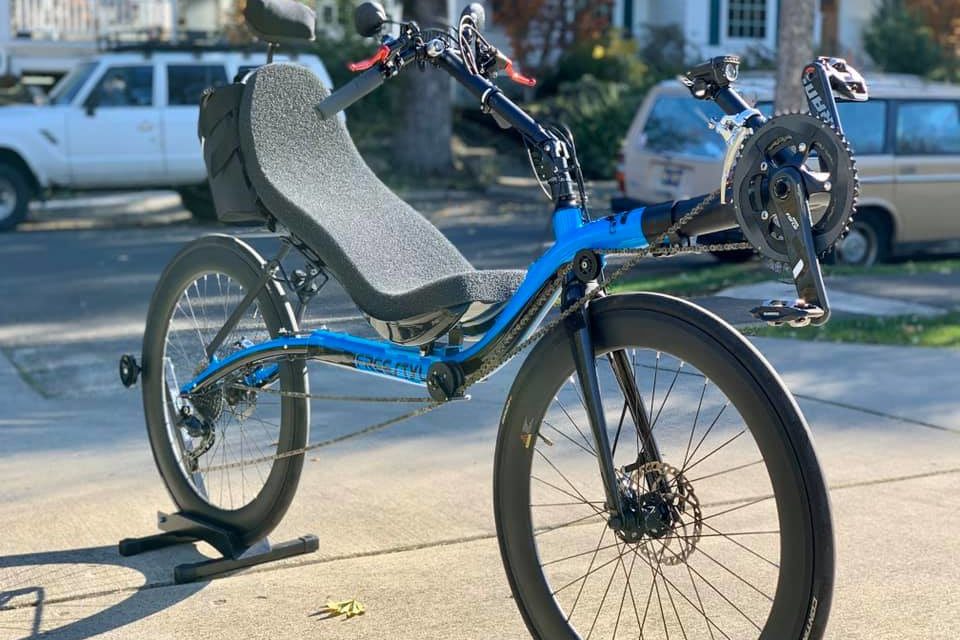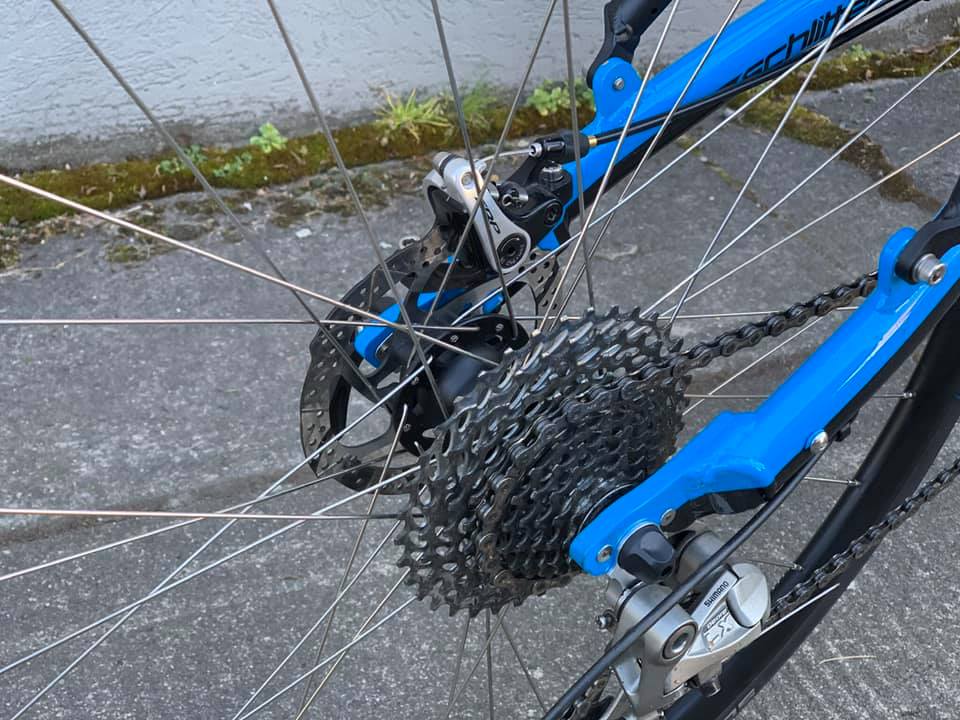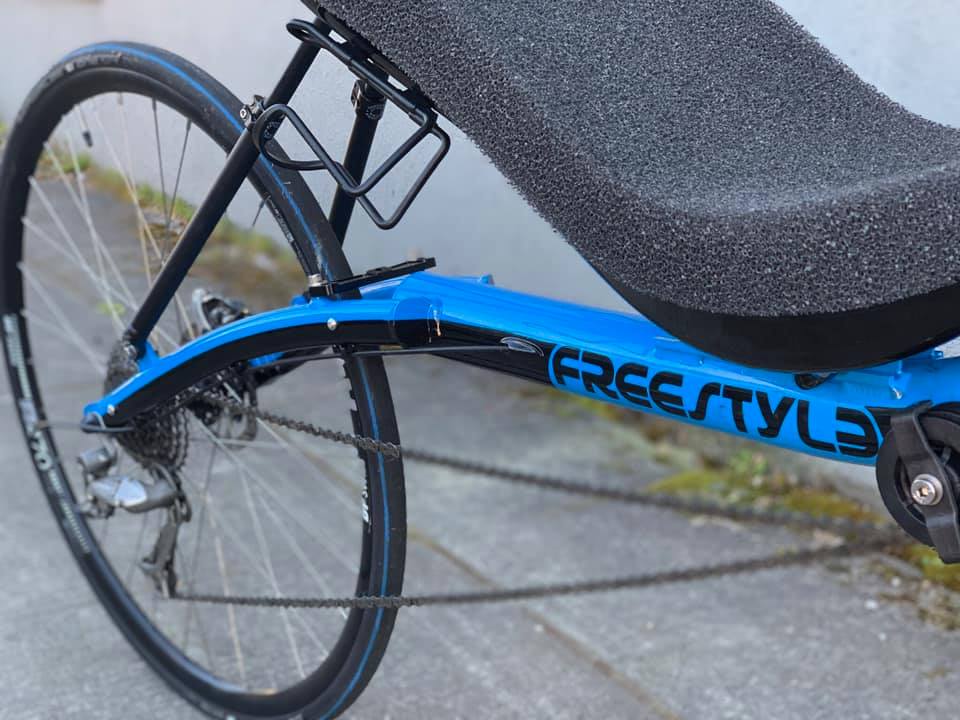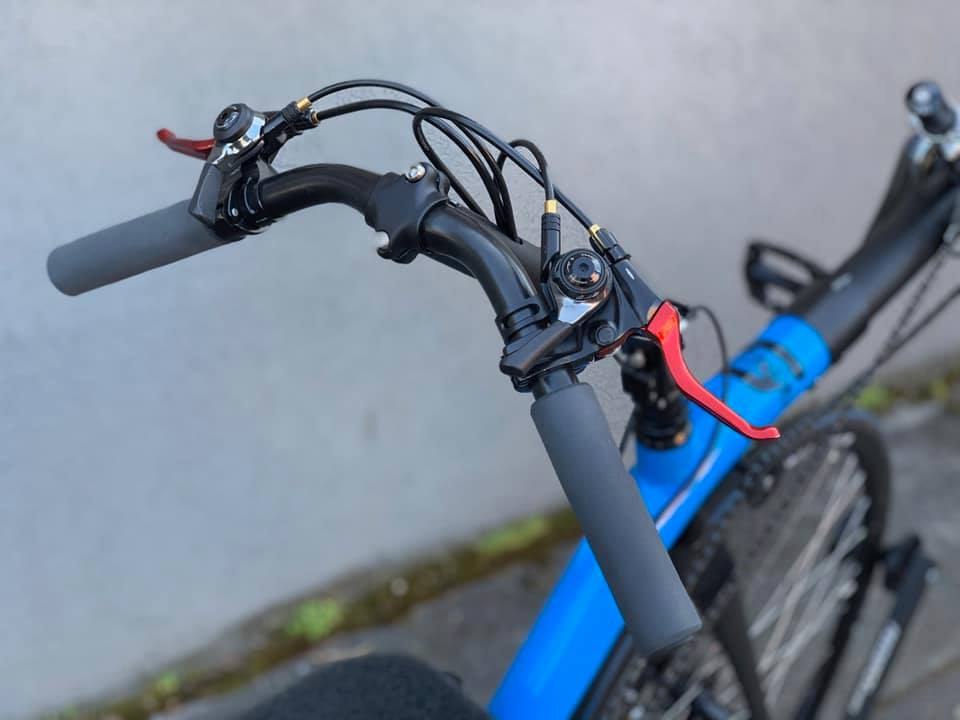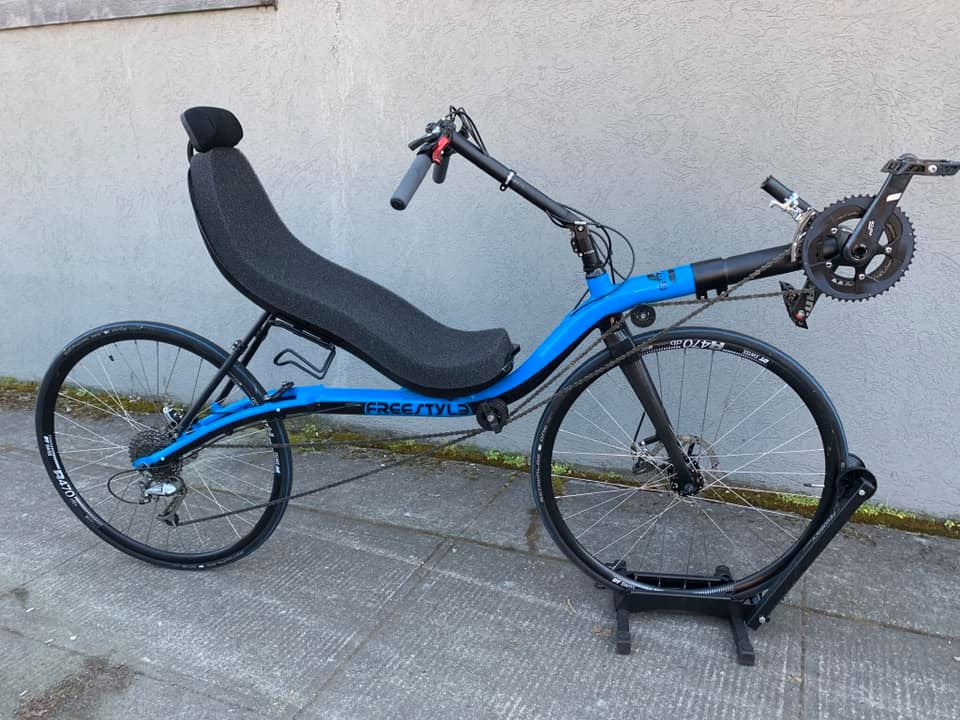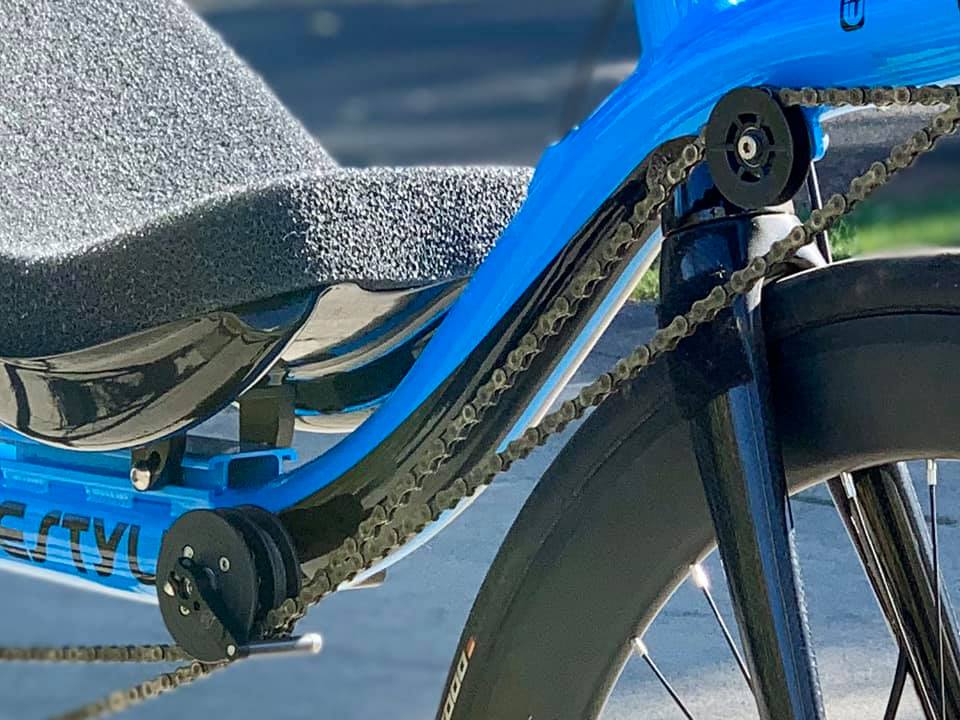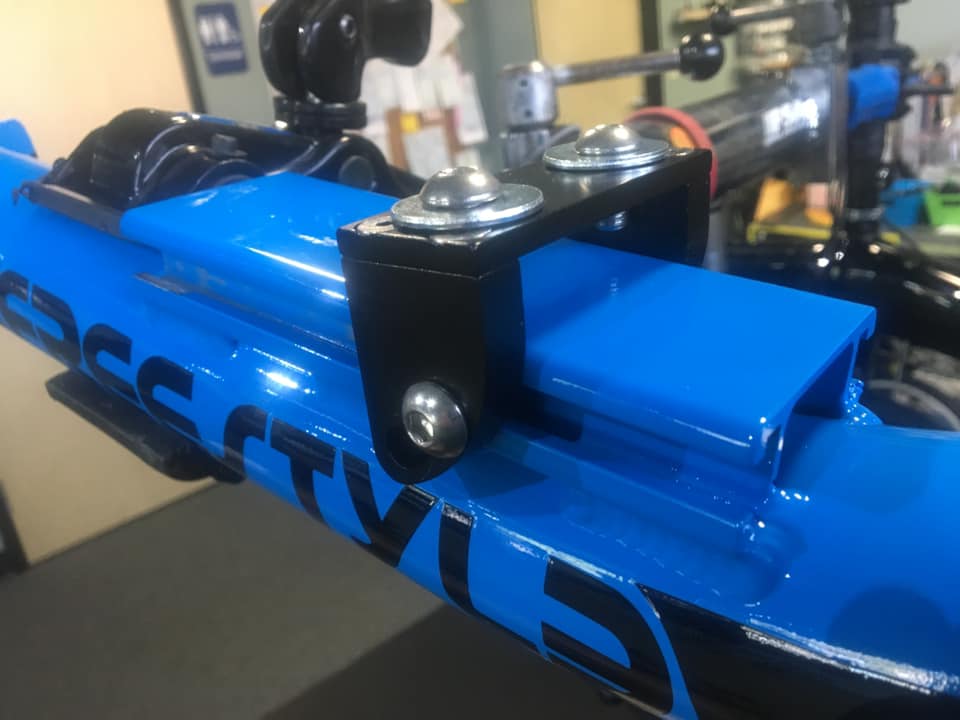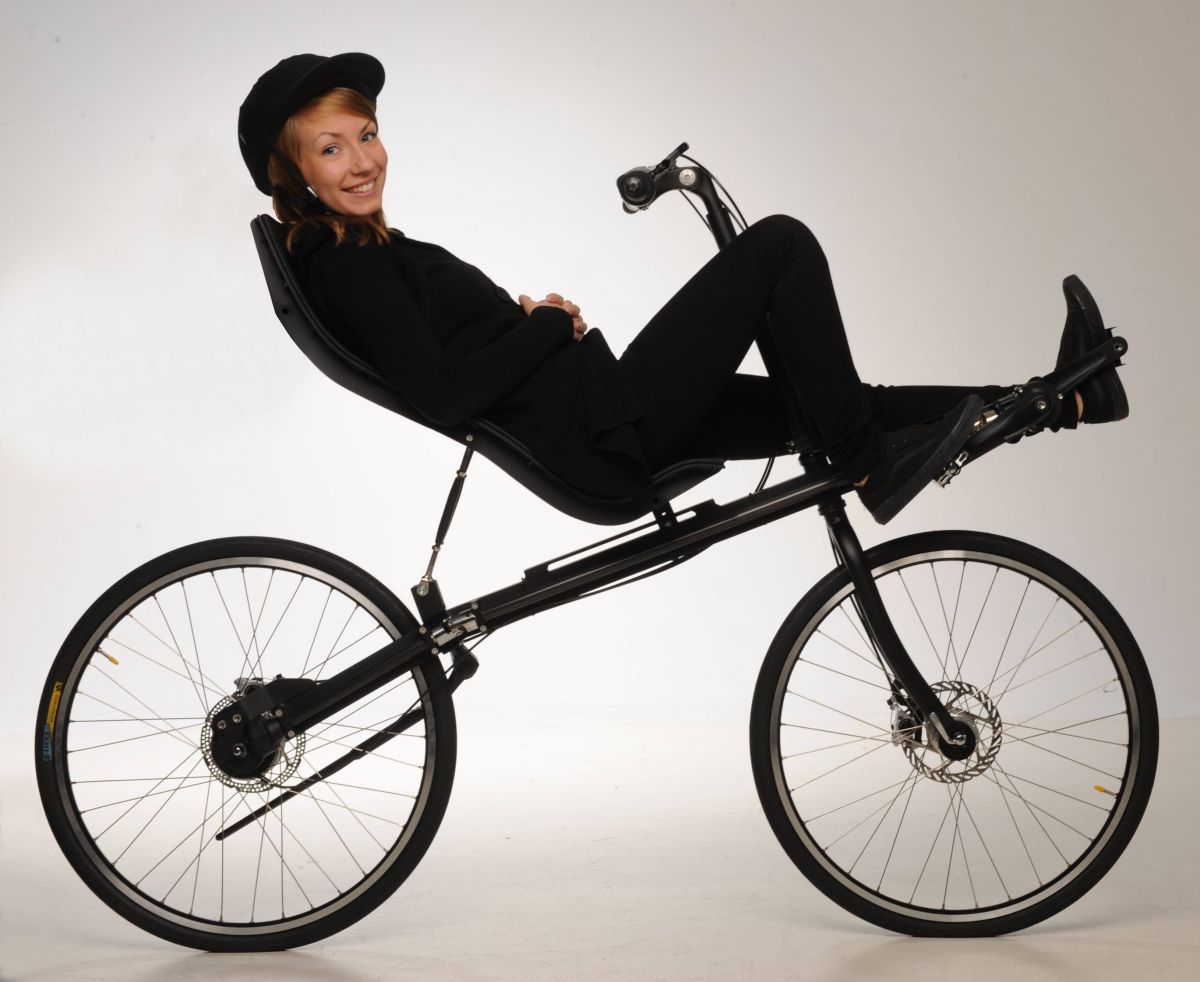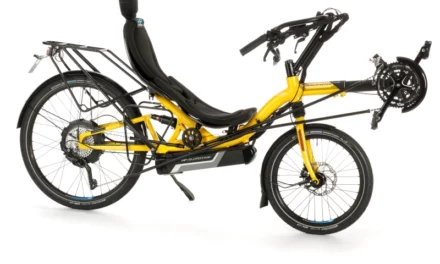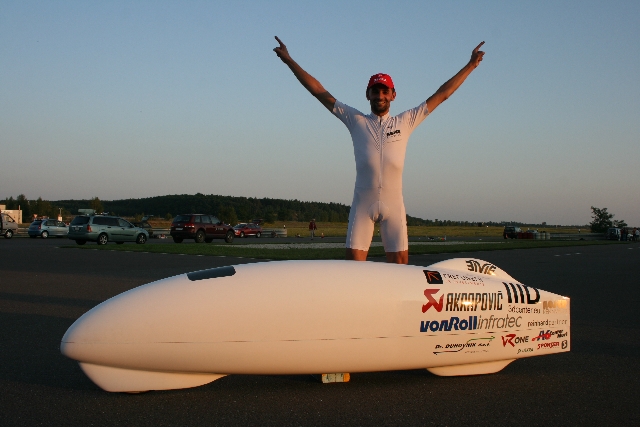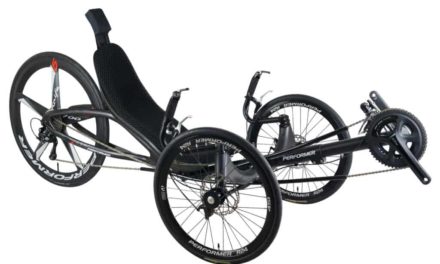Review of the Schlitter Freestyle highracer by Jonathan Garcia which I don’t want to be lost somewhere deep in the Facebook history because I think it is so well written!
The recumbent industry is a small circle – a pebble dropped in a little pond when compared to the upright world. Once in a while, a giant rock gets dropped in our little pond that continues to make waves long past the initial impact. The two Schlitter brothers are still making waves 30 years later.
Randy’s creative and engineering genius combined with John’s straightforward no nonsense athleticism and winning personality made them a force to be reckoned with in the world of recumbents. Together they brought us some of the most classic of RANS designs. After leaving RANS, John contributed to and helped develop some of the iconic Bacchetta bikes. John may also hold more race and course records than any other recumbent racer on the planet. On his own, he has helped design and develop the Schlitter Encore, The Pelso Brevet, and now the Schlitter Freestyle.
Personally, I am proud to work with Jerrell Nichols – the new owner of RANS – as their designer and product manager. Randy is still a voice and mentor for Jerrell and I. I am aware and constantly studying the legacy of RANS and how it can help give the foundation that the new RANS needs to be successful in the future.
With that in mind, if a Schlitter Brother talks, I listen. I was excited to see John’s new Freestyle at the Recumbent Cycle Con in Nashville, this last October. John had one red, one white, and one blue Freestyle frame arranged on the table in his booth and various completes with J-bar open cockpit as well as a couple with the tiller set-up. It was a good way to show how versatile the design is. At first the Freestyle name threw me off-but only on a personal level. I was a professional freestyle rider, so when I hear “Freestyle” I associate it with 20 years of relentless practice!
In an objective sense the name is perfect, in that it describes all the different ways this frame can be configured. After getting sized up by John on one of the complete bikes he sent me out the door. I chose the one with the tiller steering first. This is typically the polar opposite setup of my usual high racer ride setup.
For some background, I have always sat firmly in the open cockpit/650c/25-28 degree seat angle high racer camp. I make it my business to test everything that has come and gone in the recumbent market. What I mean by test is that I live with and own the bike – riding it on the same training course repeatedly as all my others. My favorite high racer has always been the classic RANS Force 5 with the truss frame. I love the seat to crank rise (not too high) the handling is the quick yet precise, it can lean over at great angles and it can take as much power as I can give out without flexing all over the place. My fastest times on my Strava segments overall have been on my Force 5. I also have the stick version – smooth but not as stiff – and I have even converted one Force 5 to 700c. That setup is not as fun (or fast for me). So I wanted to try the antithesis of my favorite ride when I jumped on the Freestyle: an S-frame, with tiller, and 700c wheels.
Nashville had a great test ride area, but it was glass smooth pavement that made every bike feel comfortable, so I didn’t get a real feel of the bike at first. The bars ended up interfering with the top of my leg stroke as my knees hit the levers. I went back and rode one of John’s open cockpit setups. Everything was familiar now, although the head tube in relation to the seat was much closer than I was used too and I was getting interference with pedals and the big wheel in turns – more so than on my beloved Force 5. No matter, my mind was busy setting it up this frame for my ‘style’ already. Nothing was set in stone.
While riding in Nashville, I could literally balance my weight where I wanted between the seat and boom adjustment. I was enjoying the 50” wheelbase and the low seat height when stopping. I thought that would be a put-off with such a rise from seat to crank height-but that didn’t bother me. From time to time for the rest of the weekend I came back to the booth and test rode each variation. I was encouraged to see John’s bikes were gone most times I checked back for test rides, so I usually had to wait a bit to get on one. So much for the trike dealer battle cry of “two wheel recumbents are dead!”
At some point I decided to get one for Rose City and put some miles in to really get a true test. We have one of John’s Encore’s still at the shop which I always appreciated but I have never been a Carbon guy. The word “Carbon” holds no magic in regards to a valid frame material for a recumbent. Other than a Bacchetta CA every one I have tried flexes way too much for my taste and style of riding, or is so rigid that it necessitates a ride to the dentist for filling replacement. In any case, I told John I wanted the Blue one and the deal was done.
When the Blue Freestyle I arrived in Portland I had already worked out how I was going to spec it. There was some scrambling to get the right fork (Pelso fork was the best choice for my set-up) since it has a tapered head tube. My criteria for the set-up was to try to move the boom out until I had minimal heel interference and then move the seat up to get my correct xseam. The by-product of my 41” x-seam is that I would end up relatively close to head tube with this configuration and I knew that I needed the tiller to be comfortable.
Despite my love for the open cockpit, they do not work well on any bike with a close seat to headtube measurement. The bike ends up steering like a bus. Literally. What is not quite understood by many riders, (and designers that are shooting in the dark,) is that if you use a short boom (fixed or not) it must be significantly higher than a long boom. Bacchetta traditionally has a fixed short high boom, which is great for stiffness, aerodynamics, and heel clearance. RANS has used a relatively medium length boom with a nice compromise of height and stiffness. The direct ancestor of all high racers in modern times – the Vision Saber R series – had a long boom (18”) which absolutely has no heel strike with it’s 650c wheels.
When I ride my Saber (which is not a slow bike) all I can think of is that is there is more than one way to skin a cat. However, when you extend the boom too far with a 700c wheel, you run into the very scary danger of getting your heel stuck on the backside of the wheel in a turn. This is a near automatic crash scenario. What is inherent in the Freestyle frame is the ability to choose a short or long boom and everything in between. It does require a longer slider to start with if you aren’t sure, since the actual movement of the boom once it is cut is only a couple of inches.
The genius of the design is not the movable boom, it’s the combination of the flat machined seat mount with the movable boom. Together they allow the fine tuning that any high racer may require to make it his/her favorite configuration. The flat machined seat mount allows nearly level movement across it’s range so shorter riders aren’t punished by higher seat heights like on a stick frame.
One note on fit: There is definitely a West Coast (maybe more specifically Pacific Northwest) high racer setup that contrasts with the East Coast (Maybe more specifically Florida riders) The actual geographics and individual set-up vary, but in GENERAL most ‘West Coasters” ride with a more upright seat angle than our ‘East Coast’ Brothers and Sisters in arms. The reason is that we use more upright angles is that we contend with hills a little more than our friends in some of the flatter areas back east. In my daily training ride of 12 miles I do 1000 ft of elevation gain. You may not see that much over 100 miles in Florida!
I have experimented with lower angles, but just cannot seem to generate the climbing power I need to pass the roadies on the hills unless I am in the 25 to 28 degree range. I have done 250,000 ft of elevation climbing this year on a steady rotation of two-wheeled recumbents and the one thing I can tell you about climbing fast on a recumbent is that it takes practice. You would also be surprised how little difference (tenths of a mph) there is in between recumbent platforms despite the claims of various manufacturers and riders. The Freestyle climbs steady and sure with only a hint of flex up an down in the boom when in the small ring up front. It is not one of those bikes that robs all your climbing power either. It gives back what you put in and my times on the climbs are in the same time zone as all my other bikes.
Let’s talk about ride quality. Boom at 18”, tiller at 13”, seat at 25 degrees. Body at 142 lbs. Hey this bike is smooth! Aluminum frames aren’t usually this smooth unless you are referring to a certain long wheelbase recumbent. The 50” wheelbase on the Freestyle helps. The extra length compared to my Force 5 (43”) doesn’t bother me. Sometimes long wheelbase high racers feel like they are dragging the back wheel behind them and the frame can wag like an articulated bus. Not so here.
It turns and carves with the wheels as one unit. The main tube is over 2” OD, but the stays are not what I call oversize. The main tube is bent in what I consider a European style similar to an Optima, Challenge, HP, or even Azub. The benefits are of course shorter riders can touch the ground without an issue, and secondly the low height with the long wheelbase contribute to the very solid slow speed handling that is hard to match with any brand.
Turning is predictable and controllable with very little rider input, even with a tiller setup. There are no surprises that happen from 2mph all the way to 45mph, in my experience so far. There is a subtle passive up and down feel from the S-bend and the carefully chosen tube diameter and thickness. At low speeds it absorbs (along with the wheel and tire choice) almost all the little vibrations. This is rare for an aluminum bike frame and at higher rates of speed the bigger bumps become just a little bit larger blip.
In any case, the Freestyle agrees with John’s philosophy of making a bike that is not thrown from it’s line when faced with uneven pavement or unexpected obstacles. It is smooth, controlled and confidence inspiring. Very low on what we like to call the anxiety scale. I can pedal for short distances no hands which means the geometry of this frame is very stable. What more can you ask for?
Let’s talk about weight. The price you pay for that beautiful S-bend on a recumbent is a higher frame weight. The bending process requires a thicker tube or it gets too thin at the bends and causes weak sections which can lead to early failure. I weighed the blue frame at 7.9 lbs including the boom cut to my spec and the clamp and idler. My Force 5 frame is exactly 2 lbs lighter. All in, our fully built Freestyle weighs in at 33lbs. That’s with Kelvin’s aero bag, pump, pedals, lights, etc – just like I would ride it everyday – sans bottles and tools. It could easily be 29 or 30 lbs with a slightly different spec, which puts it exactly in the ballpark of the old RANS Force 5 and Cruzbike S40. In general, I prefer a solid performer in every condition over light weight any day of the week.
Given the same quality platform with similar tires and wheels, speed on a bike is fitness based. That is a bold statement, but unless you are talking about racing bikes in a racing event where performances are measured in tenths of a second, the argument that one is ‘faster’ than another is moot and the data we have collected on nearly every recumbent two wheeler demonstrates this. What does matter is how safe, secure, comfortable, and efficient you are on a given platform. The overall subjective experience of riding it is critical as well. The ‘Best’ bike is the one you find yourself riding the most.
Chain Management is handled by a small idler up front with a under/under arrangement to make every gear work with limited noise and wheel/tire interference. I still find this arrangement much quieter and smoother than the Euro solution of multiple chain tubes. The only glitch on the Freestyle is when slightly back pedaling to launch at a stoplight the chain hangs up momentarily on the keeper. There is also a lag in the chain when first starting as the chain tensions up under pedal pressure. At speed or while pedaling when moving there is no discernible difference between the Freestyle and any of the over/under stick systems.
How does the Freestyle stack up overall? John has managed to leave behind a lot of carbon hype and high racer tradition and deliver a frame that is a perfect synthesis of the best of European and American design. Combined with a quality welding and perfect paint job from George at Performer, he has made a worthy package – one of the few new modern bikes that will hopefully attract new riders to the world of two wheel recumbents.
We may finally be inching closer to the standard set by the upright world; internal routing, thru axles, tapered head tubes, beautiful sexy graphics, a quality ride with no major surprises, etc. John has presented a finished product, not a collection of bad ideas built out of old bike frames in a garage somewhere. To be embraced in the larger biking culture, recumbent bikes have to be better than in the past and built to a higher standard. Companies can no longer be participating in a race to the bottom. The Freestyle goes a long way in that positive direction and I applaud the result. The Freestyle delivers.
This was not a paid or gifted endorsement. I paid for this bike. If you have more questions concerning the Freestyle than please contact John Schlitter at Schlitter Bikes in Florida or Jonathan at Rose City Recumbent Cycles in Portland.

